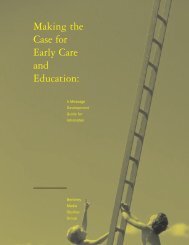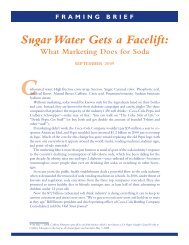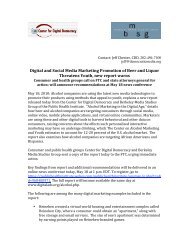Framing Brief_Talking Upstream_050409_01 - Berkeley Media ...
Framing Brief_Talking Upstream_050409_01 - Berkeley Media ...
Framing Brief_Talking Upstream_050409_01 - Berkeley Media ...
You also want an ePaper? Increase the reach of your titles
YUMPU automatically turns print PDFs into web optimized ePapers that Google loves.
FRAMING BRIEF<br />
What Surrounds Us Shapes Us<br />
Making the Case for Environmental Change<br />
MAY 2009<br />
Creating healthy environments starts with knowing what you want to change. Then you have to<br />
find the right language to talk about it effectively. Language is important because how an issue is<br />
described, or framed, can affect whether it has popular or political support.<br />
Linguists say that framing is how our minds recognize patterns of ideas, categorize them, and<br />
derive meaning from them. <strong>Framing</strong> is the translation process between incoming information—<br />
things we see, read, or hear—and the ideas already in our heads. Frames are important to advocates<br />
because they influence how people react to ideas. 1<br />
Consider one example from Kraft Foods. When Kraft reframed recipes as “solutions” rather than<br />
as “cooking,” more people requested the company’s recipes. Mary Beth West, Kraft’s Chief Marketing<br />
Officer, explained that communicating this idea in the recipe’s title could bump it to the top of Kraft’s<br />
request list: “‘Learn to cook stir-fry’ is fast to the bottom; ‘Easy stir-fry in 15 minutes’ is at the top.<br />
<strong>Framing</strong> it more as a food solution and an idea of getting dinner on the table is what it’s all about.” 2<br />
Language can create a “frame of mind” that makes some ideas attractive and others not. Whether<br />
promoting recipes or promoting policy, the frame matters.<br />
This <strong>Framing</strong> <strong>Brief</strong> suggests how to create frames that can help people see that environments<br />
affect health. When people understand that idea, they are more likely to support policies that improve<br />
those environments.<br />
Shifting from Portrait to Landscape<br />
Research shows that in the US, most of the time most people think that individuals are masters<br />
of their own destiny. People believe that hard work, discipline, and self-determination will outweigh<br />
other factors such as the conditions in which they live. These values extend to people’s perceptions<br />
about health as well: their gut-level assumption—what we call the default frame—is that individuals<br />
can control their own health outcomes if they make the right choices.<br />
The problem with the default frame is that it hides the influence of the places where people live,<br />
work, and play. The default frame is like a portrait, focused narrowly on the details of a single person.<br />
Advocates need to evoke frames that are more like landscapes—frames that include people, but also<br />
the context that surrounds them.<br />
Advocates slip into the default frame when they encourage people to eat more fruits and vegetables<br />
and fewer fatty foods, without mentioning the need for all neighborhoods to have stores that sell<br />
healthy foods at affordable prices; or when they tell parents to make sure their children get enough<br />
1 There is a growing literature on framing. For research and examples of framing applied to health, see FrameWorks Institute, www.frameworksinstitute.org and<br />
<strong>Berkeley</strong> <strong>Media</strong> Studies Group, www.bmsg.org.<br />
2 York, Emily Bryson. Kraft tests recipe for selling in a recession. Advertising Age, November 10, 2008, page 20.
exercise, but don’t make the case for neighborhoods and<br />
schools that offer safe places for children to play, free of<br />
violence and crime.<br />
Advocates need to broaden the default frame from its<br />
exclusive focus on the individual—or portrait—to a<br />
landscape perspective that makes visible the external factors<br />
in the environment. By painting a broader picture,<br />
advocates can help people see that neighborhoods,<br />
schools, and workplaces influence health. Only then will<br />
policies that improve places make sense to people.<br />
To do this, advocates need to think about what they<br />
say and ask themselves: What assumptions does our language<br />
trigger? What pictures are we bringing to mind?<br />
Do they lead to support for our policy and reinforce our<br />
values? Advocates have to start with a frame that brings<br />
to mind place. Then they can talk about the people in<br />
those places.<br />
Triggering an Environmental Frame<br />
How can advocates trigger the idea that contexts affect<br />
individuals? Research from the FrameWorks Institute<br />
suggests reminding people that where we live, work, or<br />
play (including homes, schools, offices, businesses, stores,<br />
parks, and any other physical spaces), affects our daily<br />
lives, including our health. When we improve and maintain<br />
these environments, the health of the people who<br />
live and work there improves as well.<br />
Advocates can trigger an environmental frame by<br />
starting their communications with a vivid description<br />
of the environment that contributes to poor health, as<br />
well as the kind of place that supports health. Then, advocates<br />
can state the value that motivates them to make<br />
the change they seek. To that they can add a clear, simple<br />
description of their policy. The task is to create an image<br />
of the world that, linked to the advocates’ values, accommodates<br />
their policy solutions and creates the desired<br />
place-based frame.<br />
Below is an equation that incorporates each of the<br />
variables needed to create the desired frame:<br />
ENV<br />
TRIGGER<br />
+<br />
+<br />
VALUE POLICY<br />
DESIRED<br />
FRAME<br />
For example, community members advocating for the<br />
city to work with businesses to promote corner stores<br />
that sell healthier food could combine their policy goal<br />
with the value of fairness and say something like this:<br />
3 See www.jointuse.org for background, examples, and connections to those working to establish joint use.<br />
=<br />
2<br />
“Children are healthier when their communities<br />
provide healthy food. But when neighborhood<br />
stores don’t have a selection of healthy food, people<br />
simply can’t feed their families the way they want<br />
to, and their health suffers. It’s not fair that the people<br />
in our neighborhood have plenty of access to<br />
liquor stores and junk food, but have to take two<br />
buses to get to a grocery store that sells fresh produce.<br />
That’s why we need the city council to work<br />
with us to attract a new market to our community.”<br />
The order of the statement matters because audiences<br />
will be able to understand the relevance of the policy<br />
only if they understand that environments matter when<br />
it comes to health. You may arrive at different ways to<br />
trigger that idea but the important thing is that you do<br />
it first. Usually there’s more to say about the environment<br />
than time to say it; emphasize those parts of the environment<br />
that link logically to the policy solutions you seek.<br />
Incorporating Values<br />
FrameWorks research tested three commonly shared<br />
values—fairness, ingenuity, and prevention—with good<br />
results. Linking any of the three values to environmental<br />
triggers inspired positive responses to public policy<br />
among different audiences. Here are some ways to use<br />
these values to create environmental frames:<br />
■ Use fairness to show that certain communities do not<br />
have a fair chance to live healthy lives, and that policy<br />
change will help even the playing field so all communities<br />
have access to health.<br />
■ Ingenuity, or “can-do spirit”—the idea that communities<br />
can and do work together to create lasting and<br />
meaningful change—can help people see that it is<br />
possible to establish policies that benefit the common<br />
good, even though it might be difficult.<br />
■ If you begin with statements that trigger context, you<br />
can talk about our responsibility as a community to<br />
prevent health problems by creating the environments<br />
in which all people can enjoy long-term good health.<br />
On the next page are three examples of how these<br />
values could be applied when advocating for joint use,<br />
the movement to open school facilities or community<br />
center grounds to the public to promote greater opportunities<br />
for physical activity. 3 Notice that each statement<br />
describes what joint use means and why it matters without<br />
using the technical term itself.
An environmental trigger with<br />
the fairness value:<br />
Children are healthier when they have<br />
safe places to play with well-maintained<br />
playgrounds. It’s not fair that<br />
some children in our city have this<br />
while others don’t. If we keep schoolyards<br />
open after hours, all children can<br />
have safe places to play.<br />
Message strategies need to be considered in the context<br />
of your overall objective. A frame that fits well with<br />
one objective may not fit with another. Or you may<br />
want to frame your argument differently depending on<br />
your target. For example, if your goal is to have government<br />
provide incentives for neighborhood convenience<br />
stores to carry more fresh produce, you might talk about<br />
the can-do spirit of business owners working with government<br />
to broaden their inventories with healthy food.<br />
But if your plan is to require that all convenience stores<br />
in certain neighborhoods carry fresh produce, you may<br />
make the case that it is our responsibility as a community<br />
to ensure access to healthy food for all. Experiment with<br />
language you feel comfortable using in connection with<br />
the goals you seek.<br />
The Downfall of “Choice” —<br />
A Common Trap<br />
Advocates want to expand the conversation about<br />
health from a narrow focus on personal responsibility to<br />
include the environmental landscape. Reporters and<br />
policy makers, however, will often draw the conversation<br />
back to individuals by talking about “choice.” The danger<br />
is that the more you talk about choice—even when<br />
you’re talking about the absence of choice—the more<br />
you reinforce the dominant frame of individualism.<br />
Choice is important, but the idea itself triggers an individualistic<br />
understanding of the world that distracts from<br />
the environment in which the choices are made.<br />
So, when reporters or others ask about choice, use it<br />
as an opportunity to move the conversation toward the<br />
environment, to the policy solution you seek, and the<br />
values you hold. Here are some examples of statements<br />
you could use to pivot away from choice to an environmental<br />
frame using our commonly held values.<br />
3<br />
An environmental trigger with<br />
the ingenuity value:<br />
Children are healthier when they have<br />
safe places to play. Fortunately, we<br />
already have those places: schoolyards.<br />
The smart solution is to keep schoolyards<br />
open after hours so all children<br />
can be more active.<br />
An environmental trigger with<br />
the prevention value:<br />
Children are healthier when they have<br />
safe places to play. When schoolyards<br />
are closed after hours, some children<br />
can’t play outdoors, which means they<br />
don’t get the exercise they need to be<br />
healthy. We can prevent poor health<br />
now and in the future if we keep<br />
schoolyards open after hours.<br />
FAIRNESS: “Sure, parents want to make good nutrition<br />
choices for their children, but parents don’t choose<br />
what is stocked in grocery stores or whether a grocery<br />
store with healthy food is even located in their neighborhood.<br />
It’s simply not fair that some families have easy<br />
access to healthy food and others don’t. That’s why we<br />
need to [add your policy action here].”<br />
INGENUITY OR “CAN-DO” SPIRIT: “Choice is<br />
important, but good choices are not possible in our environment.<br />
This is a big problem since we know that environments<br />
can determine whether people will be<br />
healthy. But we’ve tackled big problems before, and we<br />
can tackle this one. Let’s find the innovative ways companies<br />
and business owners can do the most good for the<br />
communities they serve. We can start by [add your policy<br />
action here].”<br />
PREVENTION: “All parents want to make the best<br />
choices for their families. But everyone’s decisions are<br />
made in a context and right now our situation doesn’t<br />
promote health. People are healthy when their communities<br />
provide healthy food and safe places to play. We can<br />
prevent future problems by creating environments that<br />
foster health for everyone. That’s why we are asking for<br />
[add your policy action here].”<br />
Conclusion<br />
Most of the time in policy battles, advocates are trying<br />
to energize and activate their supporters. They can do<br />
so when they state their solutions clearly, use frames that<br />
help people understand that environments make a difference<br />
in health, and express their values about why the<br />
solution matters.
Interview Gone Wrong<br />
Once we have figured out what has to be done, who has to do it, and how to frame the issue, then we have to talk about it, in<br />
public and on the record. <strong>Talking</strong> with journalists is especially important since policy makers pay close attention to the news.<br />
Whenever we talk with reporters we have the opportunity to educate them about the problems we see and what to do about<br />
them. But talking with reporters can be intimidating. Sometimes it’s hard to stay focused on our message, including the policy<br />
goal. Let’s use the example of a moratorium on fast food outlets and see what can happen under the pressure of an interview.<br />
REPORTER: What should we do about childhood obesity?<br />
ANSWER: We need to make healthier food more widely available in our communities. One way to do this is to<br />
stop building fast-food outlets, so neighborhoods can attract a bigger variety of food options.<br />
So far so good. Let’s keep going…<br />
REPORTER: But no one forces people to go into a McDonald’s. What does the number of fast food restaurants have<br />
to do with obesity?<br />
ANSWER: Of course we can’t guarantee that people will buy fruit instead of french fries or chips, but at least if people<br />
have healthy food available instead of junk food, we are headed in the right direction. For example, making produce available<br />
in corner stores would make it easier for families to buy healthy food.<br />
REPORTER: If people in the neighborhood wanted to purchase that sort of food, wouldn’t it already be in the stores?<br />
And why should small businesses take the risk of putting expensive, perishable produce on their shelves? Their concern<br />
is business, not health.<br />
ANSWER: People in this neighborhood already purchase that sort of food, but not as often as they want to because<br />
they have to travel so far to do it. We want to encourage business owners here to promote health. They should be held<br />
accountable for the unhealthy food they carry in their stores and restaurants. Corner stores can start by carrying small<br />
quantities of healthy food, and increase the supply once demand increases.<br />
Now you are off track. These are good points, but you wanted to focus on the specific policy goal of supporting the fast food<br />
moratorium in your city. Instead, you find yourself talking about the importance of convenience stores carrying produce—not<br />
a bad idea, but not where you wanted to end up, given your policy goal. Let’s try the interview again.<br />
REPORTER: What should we do about childhood obesity?<br />
ANSWER: We need to make healthier food more widely available in our communities. One way to do this is to<br />
stop building fast-food outlets so neighborhoods can attract a bigger variety of food options.<br />
REPORTER: But no one forces people to go into a McDonald’s. What does the number of fast food restaurants<br />
have to do with obesity?<br />
ANSWER: Policymakers can help ensure that communities are given a fair chance for health if they pay attention<br />
to the environment that affects health. Right now we have plenty of fast food outlets in our neighborhood. What is<br />
lacking are places that offer healthier menus with fresh food.<br />
REPORTER: Why should government interfere with where businesses locate? Isn’t this a free market issue? If<br />
there were a demand for other sorts of restaurants, wouldn’t businesses like that locate here?<br />
ANSWER: We have a responsibility, and our policy makers have a responsibility, to be sure neighborhoods don’t<br />
stack the deck against their residents’ health. That’s why the moratorium makes sense. We need a breather from<br />
fast food to attract other healthier businesses into the neighborhood.<br />
Now you’re on the right track. The reporter may follow up with questions about how the fast food moratorium will work,<br />
what you hope the outcome will be, or next steps. Or the reporter may ask another distracting question. But by staying on<br />
track, you will have the discussion you want to have, focused on your priority policy goal.<br />
4<br />
This <strong>Framing</strong> <strong>Brief</strong> was written by <strong>Berkeley</strong> <strong>Media</strong> Studies Group for the Strategic Alliance’s Rapid Response <strong>Media</strong> Network and The California<br />
Endowment’s Healthy Eating, Active Communities program. Both Strategic Alliance and the Rapid Response <strong>Media</strong> Network are funded by<br />
The California Endowment. For more information about this piece or the Rapid Response Network,<br />
contact Sana Chehimi, sana@preventioninstitute.org or 510-444-7738.









